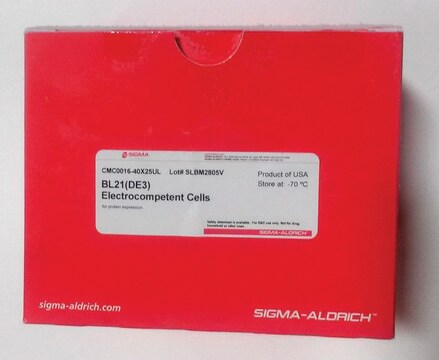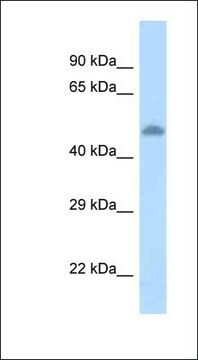추천 제품
생물학적 소스
chicken
결합
unconjugated
항체 형태
affinity isolated antibody
항체 생산 유형
primary antibodies
클론
polyclonal
양식
buffered aqueous solution
제조업체/상표
Genway 15-288-10817F
기술
western blot: suitable
NCBI 수납 번호
UniProt 수납 번호
배송 상태
wet ice
저장 온도
−20°C
타겟 번역 후 변형
unmodified
유전자 정보
human ... tat(155871)
애플리케이션
Anti-TAT antibody produced in chicken is suitable for western blotting at a working dilution of 1:500 and for cell staining at a working dilution of 1:200.
생화학적/생리학적 작용
TAT (Transactivating regulatory protein) is a trans-activator of human immunodeficiency virus-1 (HIV-1) gene expression and is important for virus replication. It binds to the bulge loop RNA element called TAR, but can also associate with cellular transcription factors. Cyclin T binds with TAT and thereby enhances the affinity of TAT-TAR RNA interaction. Protein arginine methyltransferase-6 (PRMT6) is responsible for methylation of TAT and negatively affects the association between TAT and cyclin T. TAT is involved in the activation of nuclear factor κB (NFκB), a master regulator of pro-inflammatory genes. TAT binds with α5β1 and αvβ3 integrins, and causes vascular cell migration and invasion. At the neural plasma membrane, TAT induces formation of a complex involving the low-density lipoprotein receptor-related protein (LRP), postsynaptic density protein-95 (PSD-95), N-methyl-d-aspartic acid (NMDA) receptors and neuronal nitric oxide synthase (nNOS). This complex is responsible for apoptosis in neurons and astrocytes, causing neurologic dysfunction in AIDS patients.
물리적 형태
Solution in phosphate buffered saline containing 0.02% sodium azide.
면책조항
Unless otherwise stated in our catalog or other company documentation accompanying the product(s), our products are intended for research use only and are not to be used for any other purpose, which includes but is not limited to, unauthorized commercial uses, in vitro diagnostic uses, ex vivo or in vivo therapeutic uses or any type of consumption or application to humans or animals.
적합한 제품을 찾을 수 없으신가요?
당사의 제품 선택기 도구.을(를) 시도해 보세요.
Storage Class Code
10 - Combustible liquids
WGK
WGK 1
Flash Point (°F)
Not applicable
Flash Point (°C)
Not applicable
개인 보호 장비
Eyeshields, Gloves, multi-purpose combination respirator cartridge (US)
Multifaceted activities of the HIV-1 transactivator of transcription, Tat.
K T Jeang et al.
The Journal of biological chemistry, 274(41), 28837-28840 (1999-10-03)
R A Marciniak et al.
The EMBO journal, 10(13), 4189-4196 (1991-12-01)
The Tat protein of HIV-1 trans-activates transcription in vitro in a cell-free extract of HeLa nuclei. Quantitative analysis of the efficiency of elongation revealed that a majority of the elongation complexes generated by the HIV-1 promoter were not highly processive
G Barillari et al.
Blood, 94(2), 663-672 (1999-07-09)
The Tat protein of human immunodeficiency virus type-1 (HIV-1) has been shown to be released during acute infection of T cells by HIV-1 and to promote angiogenesis and Kaposi's sarcoma (KS) development in infected individuals. In this study, we investigated
Eliseo A Eugenin et al.
Proceedings of the National Academy of Sciences of the United States of America, 104(9), 3438-3443 (2007-03-16)
HIV infection of the central nervous system can result in neurologic dysfunction with devastating consequences in AIDS patients. NeuroAIDS is characterized by neuronal injury and loss, yet there is no evidence that HIV can infect neurons. Here we show that
Baode Xie et al.
Journal of virology, 81(8), 4226-4234 (2007-02-03)
Arginine methylation has been shown to regulate signal transduction, protein subcellular localization, gene transcription, and protein-protein interactions that ultimately alter gene expression. Although the role of cellular protein arginine methyltransferases (PRMT) in viral gene expression is largely unknown, we recently
자사의 과학자팀은 생명 과학, 재료 과학, 화학 합성, 크로마토그래피, 분석 및 기타 많은 영역을 포함한 모든 과학 분야에 경험이 있습니다..
고객지원팀으로 연락바랍니다.








